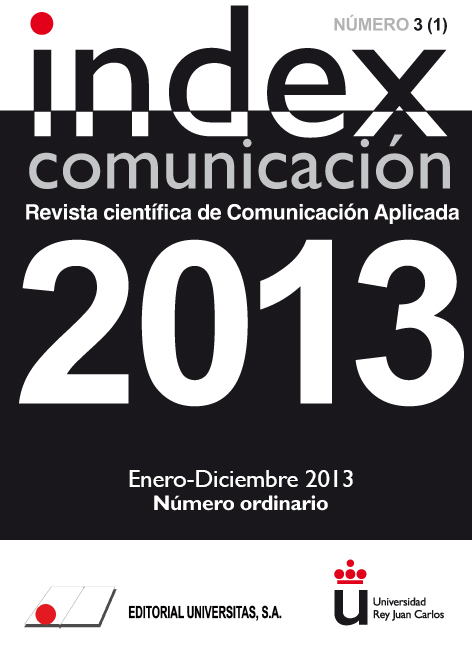Advertising Books through Documentary Applications ISBN and REBIUN: a Bibliographic Study (2008-2012)
Keywords:
Publicidad, estudio bibliográfico, monografías, aplicaciones documentales, recuperación de información, Documentación onlineAbstract
The Information and Communication Technologies have experienced a breakthrough in recent years. Documentary resources available on the Web has been put in to the researcher. This is an online documentation which is accessed by different means, but always using online systems, mainly, the Internet. The objective of this research is to evaluate the scientific production of books in the area of Advertising during 2008-2012. It has consulted the database of the International Standard Book Number (ISBN), managed by the Ministry of Education, Culture and Sports, and the Spanish University Library Network (REBIUN), sponsored by the Conference of Rectors of Spanish Universities (CRUE ), which includes the documentary the National Scientific Research Council (CSIC). The searches have been made by subject and publication date. In addition, it has studied variables as scientific production for years, the visibility of publishers and geographic coverage of publications. The results confirm the high scientific output in the discipline of Advertising with 1.298 books, ranking 2008 as the most visible, the prevalence of the Community of Madrid and Catalonia as reference publishers, as well as the relevance of these documentary applications for teachers, researchers and professionals related to the field of Advertising.Metrics
References
Ayuso García, M.ª D. (1999): ‘Revisión interdisciplinar de Bibliografía y Fuentes de Información en los umbrales del siglo XXI. Nuevas perspectivas: los recursos de información’. Revista General de Información y Documentación vol. 9 (1), pp. 203-215.
Blázquez Ochando, M. (2012): Aplicaciones documentales de la recuperación de información: aplicaciones para su mejor explotación documental. Madrid: Universidad Complutense de Madrid, Servicio de Publicaciones.
Bar-Hillel, Y. (1957): ‘A logician´s Reaction to Recent Therizing on Information Search Systems’. American Documentation, 8 (2), pp. 103-113.
Cebrián, B. (1997): Fuentes de consulta para la Documentación Informativa. Madrid: Universidad Europea-CEES.
Eguizábal, R. (2010): Teoría de la Publicidad. Madrid: Cátedra.
Flower, L. (1993): Problem Solving Strategies for Writing. Orlando: Harcourt Brace Jovanovich.
Fuentes Romero, J. J. (2003). ‘El sistema bibliotecario de la Universidad de A Coruña’. Documentación de las Ciencias de la Información, vol. 13 (1), pp. 213-246.
García, F., y Moscoso, P. (2007): ‘El sistema de ayuda al usuario de un catálogo en línea de acceso público: delimitación teórica y propuesta práctica’. Documentación de las Ciencias de la Información, vol. 30, pp. 187-199.
López, A. y Zorita, L. (2008): ‘Las bibliotecas universitarias y la gestión de la información en el entorno digital: unas consideraciones para repositorios digitales’. Bid. Textos universitaris de biblioteconomia y documentació, 20. Consultado el 12 de mayo de 2013 desde: http://www.ub.edu/bid/pdf/20lopez2.pdf
López Yepes, J. (1997): Los caminos de la información. Cómo buscar, seleccionar y organizar las fuentes de nuestra documentación personal. Madrid: Fragua.
Marcos Recio, J. C.; Martínez Pestaña, M.ª J; Blasco López, M.ª F. (2012): ‘Producción y dirección de Tesis Doctorales sobre Publicidad en la Universidad española’ (1971-2010). Revista Española de Documentación Científica, vol. 35 (3), pp. 433-452.
Marcos Recio, J. C. (2003): ‘Estrategias documentales en agencias de publicidad’. Bid. Textos universitaris de biblioteconomia y documentació, 11. Consultado el 14 de mayo de 2013 desde: http://www.ub.edu/bid/11marco2.htm
Marcos Recio, J. C. (1999): ‘Desarrollo de aplicaciones documentales: ¿para qué sirve la información en una sociedad global?’ Documentación de las Ciencias de la Información, 22, pp. 13-25.
Martínez Pestaña, M.ª J. (2011): Evaluación de la producción científica española sobre la Publicidad (1971-2001). (Tesis Doctoral inédita). Madrid: Universidad Complutense de Madrid.
Mooers, C .N. (1950): ‘Coding, Information Retrieval, and Rapid Selector’. American Documentation, 1 (4), pp. 225-229.
Moscoso, P., y Ortiz-Repiso, V. (2002). ‘El impacto tecnológico en el quehacer bibliotecario: hacia un nuevo modelo de biblioteca. La biblioteca digital’. Documentación de las Ciencias de la Información, vol. 25, pp. 115-127.
Oliva Marañón, C. (2012): ‘Las Fuentes de Información online como soporte tecnológico en la Sociedad de la Información’. Contribuciones a las Ciencias Sociales, vol. 17. Consultado el 16 de mayo de 2013 desde: http://www.eumed.net/rev/cccss/17/com.html
Orera Orera, L. (2007): ‘El control y acceso al patrimonio bibliográfico a través de los catálogos disponibles en Internet’. Documentación de las Ciencias de la Información, vol. 30, pp. 9-23.
Real Academia Española (2001): Diccionario de la Lengua Española, 22ª ed. Madrid: Espasa Calpe. Consultado el 16 de junio de 2013 desde: http://www.rae.es/rae.html
Sabor, J. E. (1957): Manual de Fuentes de Información. Buenos Aires: Kapelusz.
Sebastià, M. (1999): ‘Reflexiones en torno al software de gestión y el acceso a la información: aspectos fundamentales de la Teoría de la Recuperación de la Información en Internet’. Congreso ISKO-ESPAÑA: La representación y la organización del conocimiento en sus distintas perspectivas. IV. Granada: Universidad de Granada.
Downloads
Published
How to Cite
Issue
Section
License
Authors who submit to this journal agree to the following terms:
Authors retain copyright and ensure the magazine's right to be the first publication of the work as licensed under a Creative Commons Attribution-NoComercial 4.0 International License that allows others to share the work with an acknowledgment of authorship of the work and the initial publication in this magazine, with no commercial purpose.
Authors can establish separate additional agreements for non-exclusive distribution of the version of the work published in the magazine (for example, to an institutional repository or publish it in a book), with an acknowledgment of its initial publication in this journal.
It allows and authors are encouraged to disseminate their work electronically (eg, in institutional repositories or on their own website) prior to and during the submission process, as it can lead to productive exchanges, as well as a citation more early and most of the published work (See The Effect of Open Access).















